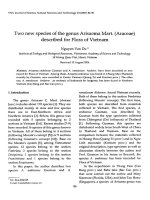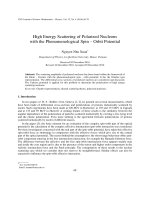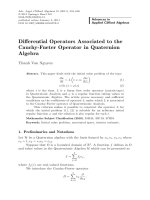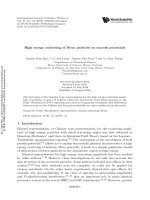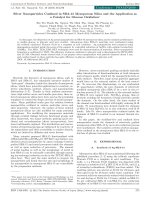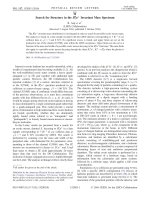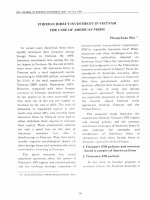DSpace at VNU: High energy scattering in the quasipotential approach
Bạn đang xem bản rút gọn của tài liệu. Xem và tải ngay bản đầy đủ của tài liệu tại đây (250.02 KB, 19 trang )
January 6, 2012 9:23 WSPC/Guidelines-IJMPA
S0217751X12500042
International Journal of Modern Physics A
Vol. 27, No. 1 (2012) 1250004 (19 pages)
c World Scientific Publishing Company
DOI: 10.1142/S0217751X12500042
Int. J. Mod. Phys. A 2012.27. Downloaded from www.worldscientific.com
by ROYAL INSTITUTE OF TECHNOLOGY on 02/01/15. For personal use only.
HIGH ENERGY SCATTERING IN
THE QUASIPOTENTIAL APPROACH
NGUYEN SUAN HAN∗ and LE THI HAI YEN
Department of Theoretical Physics, University of Science,
Vietnam National University, 334 Nguyen Trai, Thanh Xuan, Hanoi, Vietnam
∗
NGUYEN NHU XUAN
Department of Physics, Le Qui Don Technical University,
100 Hoang Quoc Viet, Cau Giay, Hanoi, Vietnam
Received 30 October 2011
Accepted 19 December 2011
Published 9 January 2012
Asymptotic behavior of the scattering amplitude for two scalar particles by scalar, vector
and tensor exchanges at high energy and fixed momentum transfers is reconsidered in
quantum field theory. In the framework of the quasipotential approach and the modified
perturbation theory a systematic scheme of finding the leading eikonal scattering amplitudes and its corrections are developed and constructed. The connection between the
solutions obtained by quasipotential and functional approaches is also discussed. The
first correction to leading eikonal amplitude is found.
Keywords: Eikonal scattering theory; quantum gravity.
PACS numbers: 11.80.-m, 04.60.-m
1. Introduction
The eikonal scattering amplitude for the high energy of the two particles in the limit
of high energies and fixed momentum transfers is found by many authors in quantum field theory,1–13 including the quantum gravity.13–24 Comparison of the results
obtained by means of the different approaches for this problem has shown that they
all coincide in the leading order approximation, while the corrections (nonleading
terms) provided by them are rather different.19,21,24–27 Determination of these corrections to gravitational scattering is now open problem.14–18 These corrections
∗ Senior
Associate of the Abdus Salam ICTP.
1250004-1
January 6, 2012 9:23 WSPC/Guidelines-IJMPA
S0217751X12500042
Int. J. Mod. Phys. A 2012.27. Downloaded from www.worldscientific.com
by ROYAL INSTITUTE OF TECHNOLOGY on 02/01/15. For personal use only.
S. H. Nguyen, T. H. Y. Le & N. X. Nguyen
play crucial role in such problems like strong gravitational forces near black hole,
string modification of theory of gravity and other effects of quantum gravity.13–24
The purpose of the present paper is to develop a systematic scheme based on
modified perturbation theory to find the correction terms to the leading eikonal
amplitude for high-energy scattering by means of solving the Logunov–Tavkhelidze
quasipotential equation.28–31 In spite of the lack of a clear relativistic covariance,
the quasipotential method keeps all information about properties of scattering
amplitude which could be received starting from general principle of quantum field
theory.29 Therefore, at high energies one can investigate the analytical properties of
the scattering amplitude, its asymptotic behavior and some regularities of a potential scattering etc. Exactly, as it has been done in the usual S-matrix theory.28 The
choice of this approach is dictated also by the following reasons: (1) in the framework
of the quasipotential approach the eikonal amplitude has a rigorous justification in
quantum field theory;6 (2) in the case of smooth potentials, it was shown that a
relativistic quasipotential and the Schr¨
odinger equations lead to qualitatively identical results.32,33
The outline of the paper is as follows. In Sec. 2 the Logunov–Tavkhelidze
quasipotential equation is written in an operator form. In the third section the
solution of this equation is presented in an exponent form which is favorable to
modify the perturbation theory. The asymptotic behavior scattering amplitude at
high energies and fixed momentum transfers is considered in the fourth section.
The lowest-order approximation of the modified theory is the leading eikonal scattering amplitude. Corrections to leading eikonal amplitude are also calculated. In
the fifth section the solution of quasipotential equation is presented in the form
of a functional path integral. The connection between the solutions obtained by
quasipotential and functional integration is also discussed. It is shown that the
approximations used are similar and the expressions for corrections to the leading
eikonal amplitude are found identical. Finally, we draw our conclusions.
2. Two-Particle Quasipotential Equation
For simplicity, we shall first consider the elastic scattering of two scalar nucleons
interacting with a scalar meson fields the model is described by the interaction
Lagrangian Lint = gϕ2 (x)φ(x). The results will be generalized to the case of
scalar nucleons interacting with a neutral vector and graviton fields later. Following Ref. 27 for two scalar particle amplitude the quasipotential equation with local
quasipotential has the form:
T (p, p′ ; s) = gV (p − p ′ ; s) + g
1
1
,
s
2
2
q2 +m2 q +m − 4 −iε
where K(q 2 , s) = √
dq V (p − q; s)K(q 2 , s)T (q, p′ ; s) ,
(2.1)
s = 4(p2 + m2 ) = 4(p ′ + m2 ) is the energy
and p, p′ and are the relative momenta of particles in the center of mass system
in the initial and final states respectively. Equation (2.1) is one of the possible
1250004-2
January 6, 2012 9:23 WSPC/Guidelines-IJMPA
S0217751X12500042
High Energy Scattering in the Quasipotential Approach
Int. J. Mod. Phys. A 2012.27. Downloaded from www.worldscientific.com
by ROYAL INSTITUTE OF TECHNOLOGY on 02/01/15. For personal use only.
generalizations of the Lippmann–Schwinger equation for the case of relativistic
quantum field theory. The quasipotential V is a complex function of the energy
and the relative momenta. The quasipotential equation simplifies considerably if V
is a function of only the difference of the relative momenta and the total energy,
i.e. if the quasipotential is local.a The existence of a local quasipotential has been
proved rigorously in the weak coupling case31 and a method has been specified for
constructing it. The local potential constructed in this manner gives a solution of
Eq. (2.1), being equal to the physical amplitude on the mass shell.28–30 Making the
following Fourier transformations
V (p − p ′ ; s) =
1
(2π)3
T (p, p ′ ; s) =
dr ei(p−p
dr dr ′ ei(pr−p
′
′ ′
)r
r )
Substituting (2.2) and (2.3) in (2.1), we obtain
g
T (r, r ′ ; s) =
V (r; s)δ (3) (r − r ′ )
(2π)3
g
dq K(q 2 ; s)V (r; s)e−qr
+
(2π)3
V (r; s) ,
(2.2)
T (r, r ′ ; s) .
(2.3)
′′
dr ′′ eiqr T (r′′ , r ′ ; s)
(2.4)
and introducing the representation
T (r, r ′ ; s) =
g
V (r; s)F (r, r ′ ; s) ,
(2π)3
(2.5)
we obtain
F (r, r ′ ; s) = δ (3) (r − r ′ ) +
×
g
(2π)3
dq K(q 2 ; s)e−iq r
′′
dr ′′ eiqr V (r ′′ ; s)F (r ′′ , r ′ ; s) .
(2.6)
Defining the pseudodifferential operator
Lr = K − ∇2r ; s ,
(2.7)
then
K(r; s) =
dq K(q 2 ; s)e−iqr = K(−∇r ; s)
dq e−iqr = Lr (2π)3 δ (3) (r) .
(2.8)
With allowance for (2.7) and (2.8), Eq. (2.6) can be rewritten in the symbolic form:
F (r, r ′ ; s) = δ (3) (r − r ′ ) + g Lr [V (r, s)F (r, r ′ , s)] .
(2.9)
Equation (2.8) is the Logunov–Tavkhelidze quasipotential equation in the operator
form.
a Since
the total energy s appears as an external parameter of the equation, the term “local” here
has direct meaning and it can appear in a three-dimensional δ-function in the quasipotential in
the coordinate representation.
1250004-3
January 6, 2012 9:23 WSPC/Guidelines-IJMPA
S0217751X12500042
S. H. Nguyen, T. H. Y. Le & N. X. Nguyen
Int. J. Mod. Phys. A 2012.27. Downloaded from www.worldscientific.com
by ROYAL INSTITUTE OF TECHNOLOGY on 02/01/15. For personal use only.
3. Modified Perturbation Theory
In the framework of the quasipotential equation the potential is defined as an infinite power series in the coupling constant which corresponds to the perturbation
expansion of the scattering amplitude on the mass shell. The approximate equation
has been obtained only in the lowest order of the quasipotential. Using this approximation the relativistic eikonal expression of elastic scattering amplitude was first
found in quantum field theory for large energies and fixed momentum transfers.26
In this paper we follow a somewhat different approach based on the idea of the
modified perturbation theory proposed by Fradkin.34,b The solution of Eq. (2.8)
can be found in the form
F (r, r ′ ; s) =
1
(2π)3
′
dk exp[W (r; k; s)]e−ik(r−r ) .
(3.1)
Substituting (3.1) in (2.9) we have
exp W (r, k; s) = 1 + g{Lr [V (r; s) exp W (r, k; s)]
+ V (r; s) exp W (r, k; s)K(k 2 ; s)} .
(3.2)
Reducing this equation for the function W (r; k; s), we get
exp W (r; k; s) = 1 + g Lr {V (r, s) exp[W (r, k; s) − ikr]}eikr .
(3.3)
The function W (r; k; s) in exponent (3.1) can now be written as an expansion in
series in the coupling constant g:
W (r; k; s) =
∞
g n Wn (r; k; s) .
(3.4)
n=1
Substituting (3.4) in (3.3) and using Taylor expansion, the l.h.s. of (3.3) is rewritten as
∞
1
1+
g Wn +
2!
n=1
n
∞
n=1
2
n
g Wn
1
+
3!
b The
∞
n=1
3
n
g Wn
+ ··· ,
(3.5)
interpretation of the perturbation theory from the viewpoint of the diagrammatic technique
is as follows. The typical Feynman denominator of the standard perturbation theory is of the form
(A): (p +
qi )2 + m2 − iε = p2 + m2 + 2p qi + ( qi )2 , where p is the external momentum
of the scalar (spinor) particle, and the qi are virtual momenta of radiation quanta. The lowest
order approximation (A) of modified theory is equivalent to summing all Feynman diagrams with
the replacement: ( qi )2 = (qi )2 in each denominator (A). The modified perturbation theory
thus corresponds to a small correlation of the radiation quanta: q i q j = 0 and is often called the
q i q j -approximation. In the framework of functional integration this approximation is called the
straight-line path approximation i.e. high energy particles move along Feynman paths, which are
practically rectilinear.22,23
1250004-4
January 6, 2012 9:23 WSPC/Guidelines-IJMPA
S0217751X12500042
High Energy Scattering in the Quasipotential Approach
and the r.h.s. of (3.3) has the form
ˆ r V (r; s) 1 +
1+g L
∞
∞
1
g Wn +
2!
n=1
n
1
+ V (r; s) 1 +
g Wn +
2!
n=1
∞
n
2
∞
n
g Wn
n=1
2
n
g Wn
n=1
1
+
3!
1
+
3!
∞
3
∞
n
g Wn
n=1
+ ···
3
n
g Wn
n=1
+ · · · K(k; s) .
Int. J. Mod. Phys. A 2012.27. Downloaded from www.worldscientific.com
by ROYAL INSTITUTE OF TECHNOLOGY on 02/01/15. For personal use only.
(3.6)
From (3.5) and (3.6), to compare with both sides of Eq. (3.3) following g coupling,
we derive the following expressions for the functions Wn (r; k; s):
W1 (r; k; s) =
dq V (q; s)K[(k + q)2 ; s]e−iqr ,
W2 (r; k; s) = −
W12 (r; k; s) 1
+
2!
2
(3.7)
dq 1 dq 2 V (q 1 ; s)V (q 2 ; s)
× K[(k + q 1 + q2 )2 ; s]
× [K(k + q 1 ; s) + K(k + q 2 ; s)]e−iq 1 r−iq 2 r ,
W3 (r; k; s) = −
W12 (r; k; s)
+
3!
(3.8)
dq 1 dq 2 dq 3 V (q 1 ; s)V (q 2 ; s)V (q 3 ; s)
× K[(k + q 1 )2 ; s]K[(k + q 1 + q 2 )2 ; s]
× K[(k + q 1 + q2 + q3 )2 ; s]e−i(q 1 +q 2 +q 3 )r .
(3.9)
Oversleeves by W1 only we obtain from Eqs. (3.1), (3.4) and (2.3) the approximate expression for the scattering amplitude26
T1 (p, p ′ ; s) =
g
(2π)3
dr ei(p−p
′
)r
V (r, s)egW1 (r,p,s) .
(3.10)
To establish the meaning of this approximation, we expand T1 in a series
in g:
(n+1)
T1
(p, p′ ; s) =
g n+1
n!
dq 1 · · · dq n V (q 1 ; s) · · · V (q n ; s)
n
×V
p − p′ −
n
K[(q i + p ′ )2 ; s] .
qi ; s
i=1
1250004-5
i=0
(3.11)
January 6, 2012 9:23 WSPC/Guidelines-IJMPA
S0217751X12500042
S. H. Nguyen, T. H. Y. Le & N. X. Nguyen
Let us compare Eq. (3.10) with the (n + 1)th iteration term of exact Eq. (2.1)
T (n+1) (p, p′ ; s) =
dq 1 · · · dq n V (q 1 ; s) · · · V (q n ; s)
n
p − p′ −
×V
K[(q 1 + p′ )2 ; s]
qi ; s
p
i=1
2
′ 2
Int. J. Mod. Phys. A 2012.27. Downloaded from www.worldscientific.com
by ROYAL INSTITUTE OF TECHNOLOGY on 02/01/15. For personal use only.
× K[(q 1 + q 2 + p ) ; s] · · · K
qi + p
′
;s ,
(3.12)
i=1
where
p is the sum over the permutations of the momenta p 1 , p 2 , . . . , p n . It
is readily seen from (3.11) and (3.12) that our approximation in the case of the
Lippmann–Schwinger equation is identical with the q i q j approximation.
4. Asymptotic Behavior of the Scattering Amplitude at
High Energies
In this section the solution of the Logunov–Tavkhelidze quasipotential equation
obtained in the previous section for the scattering amplitude can be used to find
the asymptotic behavior as s → ∞ for fixed t. In the asymptotic expressions we
shall retain both the principal term and the following term, using the formula
eW (r,p
′
;s)
= eW1 (r,p
′
;s)
1 + g 2 W2 (r, p ′ ; s) + · · · ,
(4.1)
where W1 and W2 are given by (3.7) and (3.8).
We take the z axis along the vector (p + p ′ ) then
p − p ′ = ∆⊥ ;
t = −∆2⊥ .
∆⊥ nz = 0 ;
(4.2)
Noting
K(p + p ′ ; s) =
=
1
1
s
′
2
′
2
2
(p + p ) + m (p + p ) − 4 + m2 − iε
s(qz2
s→∞
t-fixed
2
3q 2 + q 2 + q ⊥ ∆⊥
1
1− z √ ⊥
+O 2
− iε)
s(qz − iǫ)
s
,
(4.3)
and using Eqs. (3.4), (3.7) and (3.8) we obtain
W1 =
W10
s
W2 =
W20
√
s2 s
+
W11
√
s s
+O
1
s3
1250004-6
+O
,
1
s2
,
(4.4)
(4.5)
January 6, 2012 9:23 WSPC/Guidelines-IJMPA
S0217751X12500042
High Energy Scattering in the Quasipotential Approach
where
W10 = 2
dq V (q; s)
eiqr
= 2i
2
(qz − iε)2
dq V (q; s)e−iqr
W11 = −2
z
dz ′ V
q⊥2 + z′ 2; s ,
−∞
(4.6)
3qz2 + q 2⊥ + q⊥ ∆⊥
(qz − iǫ)2
q 2⊥ + z ′ 2 ; s + 2(−∇2⊥ − iq ⊥ ∇⊥ )
= −6V
Int. J. Mod. Phys. A 2012.27. Downloaded from www.worldscientific.com
by ROYAL INSTITUTE OF TECHNOLOGY on 02/01/15. For personal use only.
z
dz ′ V
×
(4.7)
dq 1 dq 2 e−i(q 1 +q 2 )r V (q 1 ; s)V (q 2 ; s)
W20 = −4
×
q 2⊥ + z ′ 2 ; s ,
−∞
3q1z q2z + q 1⊥ q2⊥
(q1z − iε)(q2z − iε)(q1z + q2z − iε)
z
= −4i 3
dz ′ V 2
q 2⊥ + z ′ 2 ; s
−∞
z′
+ ∇⊥
2
dz ′′ V 2
q ⊥ 2 + z ′′ 2 ; s
−∞
.
(4.8)
In the limit s → ∞ and (t/s) → 0 W10 makes the main contribution, and
the remaining terms are corrections. Therefore, the function exp W can be represented by means of the expansion (4.1) where W10 , W11 and W20 are determined
by Eqs. (4.6)–(4.8) respectively. The asymptotic behavior scattering amplitude can
be written in the form
T (p, p ′ ; s) =
g
(2π)3
d2 r⊥ dz ei∆⊥ r⊥ V
× exp g
W10
s
r2 + z 2 ; s
W11
W20
1 + g √ + g2 2√ + · · ·
s s
s s
.
(4.9)
Substituting (4.6)–(4.8) in (4.9) and making calculations, at high energy s → ∞
and fixed momentum transfers (t/s) → 0, we finally obtain26
T (s, t) =
g
2i(2π)3
−
×
d2 r ⊥ ei∆⊥ r⊥ × e
6g 2
√
(2π)3 s s
∞
−∞
dz V
2ig
s
∞
−∞
d2 r ⊥ ei∆⊥ r ⊥ × exp
r 2⊥ + z 2 ; s −
dz V
2ig
s
ig
√
(2π)3 s
1250004-7
√
r 2⊥ +z 2 ;s
∞
−∞
dz ′ V
−1
r 2⊥ + z 2 ; s
d2 r⊥ ei∆⊥ r⊥
January 6, 2012 9:23 WSPC/Guidelines-IJMPA
S0217751X12500042
S. H. Nguyen, T. H. Y. Le & N. X. Nguyen
×
∞
dz exp
−∞
2ig
s
− exp
×
Int. J. Mod. Phys. A 2012.27. Downloaded from www.worldscientific.com
by ROYAL INSTITUTE OF TECHNOLOGY on 02/01/15. For personal use only.
−
×
∞
z
∞
∞
dz ′ V
dz ′ ∇2⊥ V
z dz V
−∞
dz ′ V
r 2⊥ + z ′ 2 ; s
z
r 2⊥ + z ′ 2 ; s
−∞
2ig
∆2
(2π)3 s ⊥
∞
2ig
s
r 2⊥ + z ′ 2 ; s −
d2 r ⊥ V
∞
2ig
s
z
2ig
s
r 2⊥ + z 2 ; s
ei∆⊥ r⊥
r 2⊥ + z ′ 2 ; s
r 2⊥ + z 2 ; s exp
2
dz ′ ∇⊥ V
∞
dz ′ V
z
r 2⊥ + z ′ 2 ; s
.
(4.10)
In this expression (4.10) the first term describes the leading eikonal behavior of
the scattering amplitude, while the remaining terms determine the corrections of
√
relative magnitude 1/ s. The similar result Eq. (4.10) is also found by means of the
functional integration.24
As is well known from the investigation of the scattering amplitude in the Feynman diagrammatic technique, the high energy asymptotic behavior can contain
only logarithms and integral powers of s. A similar effect is observed here, since
integration of the expression (4.10) leads to the vanishing of the coefficients for
half-integral powers of s. Nevertheless, allowance for the terms that contain the
half-integral powers of s is needed for the calculations of the next corrections in
the scattering amplitude, and leads to the appearance of the so-called retardation
effects, which are absent in the principal asymptotic term.
In the limit of high energies s → ∞ and for fixed momentum transfers t the
expression for the scattering amplitude within the framework of the functionalintegration method takes the Glauber form with eikonal function corresponding
to a Yukawa interaction potential between “nucleons.” Therefore, the local quasipotential for the interaction between the “nucleons” from perturbation theory in
that region can be chosen by following forms. For the scalar meson exchange the
quasipotential decreases with energy
g 2 e−µr
.
(4.11)
8πs r
The first term in the expression (4.10) describes the leading eikonal behavior of
the scattering amplitude. Using integrals calculated in the Appendix, we find
g
(0)
TScalar(s, t) = −
d2 r ⊥ ei∆⊥ r ⊥
2i(2π)3
V (r; s) = −
× exp
=
2ig
s
+∞
dz V
−∞
r 2⊥ + z 2 ; s
−1
g4
1
g3
g6
−
F
(t)
+
F2 (t) .
1
4(2π)4 s2 µ2 − t 8(2π)2 s2
48(2π)5 s4
1250004-8
(4.12)
January 6, 2012 9:23 WSPC/Guidelines-IJMPA
S0217751X12500042
High Energy Scattering in the Quasipotential Approach
The next term in (4.10) describes first correction to the leading eikonal
amplitude
(1)
TScalar (s, t) = −
6g 2
√
(2π)3 s s
× exp
Int. J. Mod. Phys. A 2012.27. Downloaded from www.worldscientific.com
by ROYAL INSTITUTE OF TECHNOLOGY on 02/01/15. For personal use only.
=
where
2ig
s
d2 r⊥ ei∆⊥ r⊥
+∞
+∞
r 2⊥ + z 2 ; s
dz V
−∞
×
dz V
−∞
r 2⊥ + z 2 ; s
3g 4
g3
g6
2
√
−
F1 (t) +
F2 (t) ,
2
2
2
6
2
8(2π)5 s4
4(2π) s s µ − t 2(2π) s
1
F1 (t) =
t
1−
4µ2
t
ln
1−
1+
1 − 4µ2 /t
1 − 4µ2 /t
(4.13)
(4.14)
and
1
dy
F2 (t) =
0
1
µ2
ln
.
(ty + µ2 )(y − 1)
y(ty + µ2 − t)
(4.15)
A similar calculations can be applied for other exchanges with different spins. In
the case of the vector model Lint = −gϕ⋆ i∂σ ϕAσ + g 2 Aσ Aσ ϕϕ⋆ the quasipotential
is independent of energy
V (r; s) = −
g 2 e−µr
,
4π r
we find
(0)
TVector(s, t) =
(1)
TVector(s, t) =
g4
1
g3
g6
×
−
F
(t)
+
F2 (t) ,
1
2(2π)4 s
µ2 − t 4(2π)2 s
12(2π)5 s2
(4.16)
3g 4
2
g3
g6
√
×
−
F
(t)
+
F2 (t) .
1
2(2π)6 s s
µ2 − t (2π)2 s
2(2π)5 s2
(4.17)
κ4
1
κ3
κ6
×
+
F
(t)
+
F2 (t) ,
1
(2π)4
µ2 − t 2(2π)2
3(2π)5
(4.18)
In the case of tensor model,c the quasipotential increases with energy V (r; s) =
(κ s/2π)(e−µr /r), we have
2
(0)
TTensor (s, t) = −
c The
model of interaction of a scalar “nucleons” field ϕ(x) with a gravitational field gµν (x) in the
linear approximation to hµν (x);22 L(x) = L0,ϕ (x) + L0,grav (x) + Lint (x), where
L0 (x) =
1 µ
[∂ ϕ(x)∂µ ϕ(x) − m2 ϕ2 (x)] ,
2
κ
Lint (x) = − hµν (x)Tµν (x) ,
2
1
ηµν [∂ σ ϕ(x)∂σ ϕ(x) − m2 ϕ2 (x)] ,
2
Tµν (x) is the energy–momentum tensor of the scalar field. The coupling constant κ is related to
Newton’s constant of gravitation G by κ2 = 16πG.
Tµν (x) = ∂µ ϕ(x)∂ν ϕ(x) −
1250004-9
January 6, 2012 9:23 WSPC/Guidelines-IJMPA
S0217751X12500042
S. H. Nguyen, T. H. Y. Le & N. X. Nguyen
(1)
Int. J. Mod. Phys. A 2012.27. Downloaded from www.worldscientific.com
by ROYAL INSTITUTE OF TECHNOLOGY on 02/01/15. For personal use only.
TTensor (s, t) = −
3κ4
2
2κ3
2κ6
√ × 2
+
F1 (t) +
F2 (t) .
6
2
(2π) s
µ − t (2π)
(2π)5
(4.19)
To conclude this section it is important to note that in the framework of standard
field theory for the high-energy scattering, different methods have been developed
to investigate the asymptotic behavior of individual Feynman diagrams and their
subsequent summation. In different theories including quantum gravity the calculations of Feynman diagrams in the eikonal approximation is proceed in a similar way
as analogous the calculations in QED. Reliability of the eikonal approximation depends on spin of the exchanges field.7,8 The eikonal captures the leading behavior of
each order in perturbation theory, but the sum of leading terms is subdominant to
the terms neglected by this approximation. The reliability of the eikonal amplitude
for gravity is uncertain.18 Instead of the diagram technique perturbation theory, our
approach is based on the exact expression of the scattering amplitude and modified
perturbation theory which in lowest order contains the leading eikonal amplitude
and the next orders are its corrections.
5. Relationship Between the Operator and
Feynman Path Methods
What actual physical picture may correspond to our result given by Eq. (4.10)?
To answer this question we establish the relationship between the operator and
Feynman path methods in Refs. 35 and 36, which treats the quasipotential equation
in the language of functional integrals. The solution of this equation can be written
in the symbolic form:
exp(W ) =
1
×1
1 − gK[(−i∇ − k)2 ]V (r)
= −i
∞
0
dτ exp[iτ (1 + iε)] × exp{−iτ gK[(−i∇ − k)2 ]V (r)} × 1 . (5.1)
In accordance with the Feynman parametrization,35,36 we introduce an ordering
index η and write Eq. (5.1) in the form
exp(W ) = −i
∞
dτ eiτ (1+iε)
0
× exp −ig
∞
dη K[(−i∇η+ε − k)2 ]U (r η ) × 1 .
0
(5.2)
Using Feynman transformation
F [P (η)] =
Dp
x(0)=0
Dx
(2π)3
τ
× exp i
0
dη r˙ (η)[p(η) − P (η)] F [p(η)] ,
1250004-10
(5.3)
January 6, 2012 9:23 WSPC/Guidelines-IJMPA
S0217751X12500042
High Energy Scattering in the Quasipotential Approach
we write the solution of Eq. (2.8) in the form of the functional integral
∞
exp(W ) = −i
dτ eiτ (1+iε)
Dp
0
x(0)=0
Dx
(2π)3
τ
× exp i
˙
dη x(η)[p(η)
− P (η)] G(x, p; τ ) × 1 .
0
(5.4)
In Eq. (5.4) we enter the function G:
Int. J. Mod. Phys. A 2012.27. Downloaded from www.worldscientific.com
by ROYAL INSTITUTE OF TECHNOLOGY on 02/01/15. For personal use only.
τ
G(x, p; τ ) = exp − i
˙
dη x(η)∇
η+ε
0
τ
× exp −ig
0
dη K[(p(η) − k)2 ]V (r η ) ,
(5.5)
which satisfies the equation
dG
˙ − ε))∇}G ,
= {−igK[(p(τ ) − k)2 ]V (r − x(τ
dτ
G(τ = 0) = 1 .
(5.6)
Finding from Eq. (5.6) the operator function G and substituting it in Eq. (5.6)
for W we obtained the following final expression:
∞
exp(W ) = −i
×
dτ eiτ (1+iε)
Dp
0
x(0)=0
Dx
exp i
(2π)3
1
(2π)3
τ
˙
dη x(η)p(η)
exp g
,
(5.7)
0
where
= −i
∞
0
dτ K[(p(η) − k)2 ]
τ
×V r−
2
τ1
=−
0
τ2
0
0
˙
dξ x(ξ)ϑ(ξ
− η + ε) ,
dτ1 dτ2 K[(p(η1 ) − k)2 ]K[(p(η2 ) − (k))2 ]
τ1
× V r1 −
0
τ2
× V r2 −
(5.8)
0
˙
dξ x(ξ)ϑ(ξ
− η + ε)
˙
dξ x(ξ)ϑ(ξ
− η + ε) .
(5.9)
Writing out the expansion2–5
exp(W ) = exp g
= exp g
1250004-11
∞
gn
n!
n=0
−
n
,
January 6, 2012 9:23 WSPC/Guidelines-IJMPA
S0217751X12500042
S. H. Nguyen, T. H. Y. Le & N. X. Nguyen
in which the sign of averaging denoted integration with respect to τ , x(η) and p(η)
with the corresponding measure (see, e.g. Eq. (5.7)), and performing the calculations, we find
2
W1 =
,
W2 =
−
2!
Int. J. Mod. Phys. A 2012.27. Downloaded from www.worldscientific.com
by ROYAL INSTITUTE OF TECHNOLOGY on 02/01/15. For personal use only.
3
1
3
2
−
−3
−
W3 =
3!
i.e. the expressions (5.10) and (4.1) are identical:
= −i
W1 =
∞
0
,
(5.10)
2
, etc.
dτ K[(p(η) − k)2 ]
τ
× exp −
0
˙
dξ x(ξ)ϑ(ξ
− η + ε)∇η V (r )
dq e−qr K[(q + k)2 ]V (q; s) ,
=
2
2
(5.11)
= K[(∇r1 + ∇r 2 + k)2 ]K[(∇r1 + k)2 ]
× K[(∇r 2 + k)2 ]V (r 1 ; s)V (r 2 ; s)
=
dq 1
dq 2 e−i(q 1 +q 2 )r K[(q 1 + q 2 + k)2 ]
× {K[(q 1 + k)2 ] + K[(q 2 + k)2 ]}V (r 1 ; s)V (r 2 ; s) ,
W2 = −
W12
1
+
2!
2
dq 1 dq 2 V (q 1 )V (q 2 )
× K[(q 1 + k)2 ; s] + K[(q 2 + k)2 ; s]} ,
W3 = −
W13
+
3!
(5.12)
(5.13)
dq 1 dq 2 dq 3 V (q 1 ; s)V (q 2 ; s)V (q 3 ; s)
× K[(k + q 1 )2 ; s]K[(k + q 1 + q 2 )2 ; s]
× K[(k + q 1 + q2 + q3 )2 ; s]e−i(q 1 +q 2 +q 3 )r ; etc.
(5.14)
Restricting ourselves in the expansion (5.10) to the first term (n = 0), we obtain
the approximate expression (4.12) for the scattering amplitude, which corresponds
to the allowance for the particle Feynman paths. These paths can be considered as
a classical paths and coincide in the case of the scattering of high energy particles
through small angles to straight-line paths trajectories.
6. Conclusions
Asymptotic behavior of scattering amplitude for two scalar particles at high energy
and fixed momentum transfers was studied. In the framework of quasipotential
1250004-12
January 6, 2012 9:23 WSPC/Guidelines-IJMPA
S0217751X12500042
High Energy Scattering in the Quasipotential Approach
approach and the modified perturbation theory the systematic scheme of finding the corrections to the principal asymptotic leading scattering amplitudes was
constructed and developed. Results obtained by two different approaches (quasipotential and functional) for this problem, as it has shown that they are identical.
Results obtained by us are extended to the case of scalar particles of the field ϕ(x)
interacting with a vector and gravitational fields. The first correction to the leading
eikonal scattering amplitude in quantum field theory was obtained.
Int. J. Mod. Phys. A 2012.27. Downloaded from www.worldscientific.com
by ROYAL INSTITUTE OF TECHNOLOGY on 02/01/15. For personal use only.
Acknowledgments
We are grateful to Profs. B. M. Barbashov, V. N. Pervushin for valuable discussions and Prof. G. Veneziano for suggesting this problem and his encouragement.
N. S. Han is also indebted to Prof. H. Fried for reading the manuscript and making
useful remarks for improvements. This work was supported in part by the International Center for Theoretical Physics, Trieste, the Abdus Salam International
Atomic Energy Agency, the United Nations Educational, Scientific and Cultural
Organization, by a grand TRIGA and by the Vietnam National University under
Contract QG.TD.10.02.
Appendix A. The Kernel of the Quasipotential Equation29
We denote by G(p, p ′ , εp , εq , E) the total Green function for two particles, where
√
p and p ′ are the momenta of the initial and final states in c.m.s. and 2E = s is
the total energy.
In these notations the Bethe–Salpeter equation is of the form
G(p, p ′ , εp , εp′ , E)
= iF (p, εp , E)δ(p − p′ )δ(εp − εp′ )
+ F (p, εp , E)
K(p, q, εp , ε, E)G(q, p ′ , ε, εp′ , E)dq dε ,
(A.1)
where
iF (p, εp , E) =
2
D(E + εp , p)D(E − εp , p) ,
π
1
D(E + εp , p) =
.
(E + εp )2 − p2 − m2 + iǫ
(A.2)
Now we introduce formally the scattering amplitude T which on the mass-shell
εp = εp′ = 0, p2 = p′ 2 = E 2 − m2 gives the physical scattering amplitude:
G(p, p ′ , εp , εp′ , E) − iF (p, εp , E)δ(p − p ′ )δ(εp − εp′ )
= iF (p, εp , E)T (p, p′ , εp , εp′ , E)F (p ′ , εp′ , E) .
1250004-13
(A.3)
January 6, 2012 9:23 WSPC/Guidelines-IJMPA
S0217751X12500042
S. H. Nguyen, T. H. Y. Le & N. X. Nguyen
Then inserting (A.3) into (A.1), we get for T the equation
T (p, p ′ , εp , εp′ , E)
= K(p, p ′ , εp , εp′ , E) +
dq dε K(p, q, εp , ε, E)F (q, ε, E)T (q, p′ , ε, εp′ , E) .
(A.4)
Int. J. Mod. Phys. A 2012.27. Downloaded from www.worldscientific.com
by ROYAL INSTITUTE OF TECHNOLOGY on 02/01/15. For personal use only.
We wish to obtain an equation of the Lippmann–Schwinger type for a certain
function T (p, p ′ , E) which on the mass-shell p2 = p′ 2 = E 2 − m2 would give the
physical scattering amplitude:
T (p, p ′ , E) = V (p, p′ , E) +
dq V (p, q, E)F (q, E)T (q, p ′ , E) ,
(A.5)
where
F (q, E) =
=−
=
dε F (q, ε, E)
2i
π
dε
q2
m2 (q 2
(E +
ε)2
1
1
×
2
2
2
−p −m
(E − ε) − p2 − m2
1
+
+ m2 − E 2 )
On the mass-shell, the total energy E =
out in Eq. (2.1)
√
s
K(q 2 ; s) ≡ F q, E =
=
2
√
s
2 ,
.
(A.6)
we receive the kenel that is brought
1
q 2 + m2 q 2 + m2 −
s
4
.
(A.7)
This can be achieved by a conventional choice of the potential V (p, p ′ , E), which
can obviously be made by different methods. There are two methods that have
been suggested for constructing a complex potential dependent on energy with the
help of which one can obtain from an equation of the Schr¨
odinger type the exact
scattering amplitude on the mass-shell.
The first method is based on the two-time Green function27 which in the momentum space is defined
G(p, p ′ , E) =
dεp dεp′ G(p, p ′ , εp , εp′ , E) .
(A.8)
Then using (A.3) and (A.8) we can determine the corresponding off-shell scattering amplitude
T1 (p, p′ , E) =
1
F (p, E)F (p ′ , E)
×
F (p, εp , E)T (p, p′ , εp , εp′ , E)F (p ′ , εp′ , E)dεp dεp′ .
1250004-14
(A.9)
January 6, 2012 9:23 WSPC/Guidelines-IJMPA
S0217751X12500042
High Energy Scattering in the Quasipotential Approach
From expression (A.9) it is directly seen that T on mass-shell p2 = p′ 2 =
E − m2 coincides with the scattering amplitude T (p, p ′ , 0, 0, E) ≡ T (p, p ′ , E).
The potential V1 for Eq. (A.5) is constructed by iteration of Eqs. (A.4), (A.5) and
(A.9). In particular, in the lowest order, we have
2
V1 (p, p ′ , E) =
1
F (p, E)F (p ′ , E)
F (p, εp , E)K(p, p′ , εp , εp′ , E)F (p ′ , εp′ , E)dεp dεp′ .
Int. J. Mod. Phys. A 2012.27. Downloaded from www.worldscientific.com
by ROYAL INSTITUTE OF TECHNOLOGY on 02/01/15. For personal use only.
×
(A.10)
The second method consists in constructing the potential V2 for Eq. (A.4) by
means of the scattering amplitude T on the mass-shell obtained by perturbation
theory, e.g. from Eq. (A.4) and the iterations of Eq. (A.5) accompanied by the
transition to the mass-shell.
We write down Eq. (A.5) in the symbolic form T2 = V2 + V2 × T2 and obtain in
the lowest orders of V2 the expressions
(2)
= T (2) ,
(6)
= T (6) − V2
V2
V2
(2)
(2)
V (4) = T (4) − V2
(2)
(4)
× T2
(4)
− V2
× T2
(2)
× T2
,
(A.11)
··· ,
where the square brackets mean here the transition to the mass-shell. Hence, it
follows that in the second method we get a local potential dependent only on
(p − p ′ )2 and E and in r-space on r and E.
We shall consider, as an example, the application of the above methods to a
model of quantum field theory, in which scalar particles of mass m interact by
exchanging scalar “photons” of small mass µ. We shall put µ = 0 where it is
possible. In the ladder approximation (without considering the crossing symmetry)
the kernel of Eq. (A.5) is of the form
K(p, p ′ , εp , εp′ , E) = −
ig 2
1
.
(2π)4 (εp − εp′ )2 − (p − p′ )2 − µ2 + iǫ
(A.12)
Appendix B. Some Integrals Used in this Paper
We consider the integral
I1 =
∞
dz V
−∞
g2
r 2⊥ + z 2 ; s = −
8πs
∞
dz
−∞
we have
I1 = −
g2
4(2π)4 s
d3 p
=−
g2
4(2π)4 s
d3 p
+∞
dz
−∞
+∞
dz
−∞
eipr
+ p2
µ2
ei(p⊥ r⊥ +p// z)
µ2 + p 2
1250004-15
e
−µ
√
r 2⊥ +z 2
r 2⊥ + z 2
(B.1)
January 6, 2012 9:23 WSPC/Guidelines-IJMPA
S0217751X12500042
S. H. Nguyen, T. H. Y. Le & N. X. Nguyen
=−
g2
4(2π)4 s
Int. J. Mod. Phys. A 2012.27. Downloaded from www.worldscientific.com
by ROYAL INSTITUTE OF TECHNOLOGY on 02/01/15. For personal use only.
2
+∞
ei(p⊥ r⊥ )
µ2 + p 2
d3 p
−∞
ei(p⊥ r⊥ )
× (2π)δ(p// )
µ2 + p2⊥ + p2//
=−
g
4(2π)4 s
d2 p⊥ dp//
=−
g2
4(2π)3 s
d2 p⊥ ei(p⊥ r⊥ )
=−
g2
4(2π)3 s
d2 p⊥
i(p⊥ r⊥ )
1
2π
with K0 (µ|r⊥ |) =
d2 p⊥ eµ2 +p2
dzeip// z
dp//
µ2
δ(p// )
+ p2⊥ + p2//
ei(p⊥ r⊥ )
g2
=−
K0 (µ|r⊥ |) ,
2
2
µ + p⊥
4(2π)2 s
(B.2)
is the MacDonald function of zeroth order.
⊥
The integral
d2 r⊥ ei∆⊥ r⊥ K0 (µ|r⊥ |)
I2 =
= (2π)
d|r⊥ ||r⊥ |J(0) (∆⊥ |r⊥ |)K0 (µ|r⊥ |) =
The integral
2π
.
−t
(B.3)
µ2
d2 r⊥ ei∆⊥ r⊥ K02 (µ|r⊥ |)
I3 =
d2 r⊥ ei∆⊥ r⊥
=
=
1
2π
=
1
(2π)
2π
d2 q
1
2π
1
q 2 + µ2
d2 q
d2 q
eiqr ⊥
K0 (µ|r⊥ |)
q 2 + µ2
d2 r⊥ ei(q+∆⊥ )r⊥ K0 (µ|r⊥ |)
1
1
,
q 2 + µ2 (q + ∆⊥ )2 + µ2
(B.4)
here, the result of the integral that obtained from calculating I2 have been used.
Using method of Feynman parameter integral
1
I3 =
dx
d2 q ×
dx
d2 q
0
1
=
0
1
=
dx
0
1
ab
=
1
dx
,
0 [ax+b(1−x)]2
1
(q 2
+
µ2 )x
+ [(q + ∆⊥ )2 + µ2 ](1 − x)
1
[q 2 + 2q∆⊥ (1 − x) + ∆2⊥ (1 − x) + µ2 ]2
i(−π)Γ(1)
[∆2⊥ (1 − x) + µ2 − ∆2⊥ (1 − x)2 ]Γ(2)
1
= (−iπ)
dx
0
1
[µ2
we have
+
∆2⊥ x(1
− x)]
1250004-16
2
January 6, 2012 9:23 WSPC/Guidelines-IJMPA
S0217751X12500042
High Energy Scattering in the Quasipotential Approach
1
dx
[µ2 − tx(1 − x)]
= (−iπ)
0
= (−iπ) ×
1
t
1−
4µ2
t
ln
1−
1−
4µ2
t
1+
1−
4µ2
t
≡ (−iπ) × F1 (t) .
(B.5)
Finally, we calculate the integral
d2 r⊥ ei∆⊥ r⊥ K03 (µ|r⊥ |)
Int. J. Mod. Phys. A 2012.27. Downloaded from www.worldscientific.com
by ROYAL INSTITUTE OF TECHNOLOGY on 02/01/15. For personal use only.
I4 =
d2 r⊥ ei∆⊥ r⊥
=
×
=
d2 q2
d2 q1
eiq1 r⊥
q12 + µ2
eiq2 r⊥
K0 (µ|r⊥ |)
q22 + µ2
d2 q1 d2 q2
(q12 + µ2 )(q22 + µ2 )
1
(2π)2
×
=
1
2π
1
2π
d2 x⊥ exp[i(q1 + q2 + ∆⊥ )x⊥ ]K0 (µ|r⊥ |)
1
(2π)2
d2 q1 d2 q2 ×
1
. (B.6)
(q12 + µ2 )(q22 + µ2 )[(q1 + q2 + ∆⊥ )2 + µ2 ]
Apply the result that we obtained when calculating I3 to this integral, we derive
d2 q1
so
1
= (−iπ)
(q12 + µ2 )[(q1 + q2 + ∆⊥ )2 + µ2 ]
I4 =
1
(−iπ)
(2π)2
1
d2 q2 ×
dx
0
1
dx
0
1
,
[µ2 + (q2 + ∆⊥ )2 x(1 − x)]
1
.
(q22 + µ2 )[µ2 + (q2 + ∆⊥ )2 x(1 − x)]
From method of Feynman parameter integral, again, we obtain
I4 = −
i
(4π)
×
1
0
d2 q2
dy
0
1
{[(q2 + ∆⊥ )2 + B]y + (q22 + µ2 )(1 − y)}2
1
=−
i
(4π)
=−
i
(−iπ)
(4π)
=−
1
dx
x(1 − x)
1
4
1
0
0
1
dx
x(1 − x)
1
0
dx
x(1 − x)
0
dx
x(1 − x)
1
dy
0
d2 q2
dy
1
dy
0
(q22
1
+ 2q2 ∆⊥ y + C)2
1
[C − (∆⊥ y)2 ]
1
,
[C − (∆⊥ y)2 ]
1250004-17
(B.7)
January 6, 2012 9:23 WSPC/Guidelines-IJMPA
S0217751X12500042
S. H. Nguyen, T. H. Y. Le & N. X. Nguyen
where
B=
µ2
,
x(1 − x)
C=
(∆2⊥
µ2
− t y + µ2 (1 − y) ,
+ B)y + µ (1 − y) =
x(1 − x)
(B.8)
2
Int. J. Mod. Phys. A 2012.27. Downloaded from www.worldscientific.com
by ROYAL INSTITUTE OF TECHNOLOGY on 02/01/15. For personal use only.
then
I4 = −
1
4
=−
1
4
=−
1
4
=−
1
4
=−
1
4
=−
1
4
1
0
1
1
dy
0
1
0
0
1
0
1
0
dy
D
1
Dx2 − Dx + µ2
1
dx
x2
0
1
0
− t y + µ2 (1 − y) + ty 2
dx
0
dy
D
µ2
x(1−x)
1
−(1 − y)(ty − µ2 )x(1 − x) + µ2
1
dy
0
1
dy ×
dx
0
1
1
dx
x(1 − x)
−x+
µ2
D
dx
(x − x1 )(x − x2 )
dy
1
(1 − x1 )x2
ln
,
D x1 − x2
(1 − x2 )x1
(B.9)
here, D = −(1 − y)(ty − µ2 ) = ty 2 + (µ2 − t)y + µ2 and x1 ; x2 are roots of equation
2
x2 − x + µD = 0.
Noting that x1 + x2 = 1 ⇒ 1 − x1 = x2 ; 1 − x2 = x1 , and
x1 − x2 =
1−
4µ2
2µ2
≈1−
,
D
D
(B.10)
hence
1−
(1 − x1 )x2
x2
ln
= ln 22 = 2 ln
(1 − x2 )x1
x1
1+
1−
4µ2
D
1−
4µ2
D
≈ 2 ln
µ2
D − µ2
(B.11)
so that
I4 = −
1
2
=−
1
2
1
dy
1
µ2
ln
2
D − 2µ
D − µ2
dy
1
µ2
1
ln
≡ − F2 (t) .
2
2
(ty + µ )(y − 1)
y(ty + µ − t)
2
0
1
0
1250004-18
(B.12)
January 6, 2012 9:23 WSPC/Guidelines-IJMPA
S0217751X12500042
High Energy Scattering in the Quasipotential Approach
Int. J. Mod. Phys. A 2012.27. Downloaded from www.worldscientific.com
by ROYAL INSTITUTE OF TECHNOLOGY on 02/01/15. For personal use only.
References
1. H. D. I. Abarbanel and C. Itzykson, Phys. Rev. Lett. 23, 53 (1969).
2. B. M. Barbashov, S. P. Kuleshov, V. A. Matveev, V. N. Pervushin, A. N. Sissakian
and A. N. Tavkhelidze, Phys. Lett. B 33, 484 (1970).
3. H. M. Fried, Functional Methods and Models in Quantum Field Theory (MIT Press,
1972).
4. H. M. Fried, Functional Methods and Eikonal Models (Editions Frontieres, 1990).
5. H. M. Fried, Green’s Functions and Ordered Exponentials (Cambridge University
Press, 2002).
6. V. R. Garsevanishvili, V. A. Matveev, L. A. Slepchenko and A. N. Tavkhelidze, Phys.
Lett. B 29, 191 (1969).
7. G. Tikotopoulos and S. B. Treinman, Phys. Rev. D 3, 1037 (1971).
8. E. Eichen and R. Jackiw, Phys. Rev. D 4, 439 (1971).
9. M. Levy and J. Sucher, Phys. Rev. 186, 1656 (1969).
10. M. Levy and J. Sucher, Phys. Rev. D 2, 1716 (1971).
11. L. N. Lipatov, Phys. Lett. B 116, 411 (1992).
12. L. N. Lipatov, Nucl. Phys. B 365, 614 (1991).
13. G. ’t Hooft, Phys. Lett. B 198, 61 (1987).
14. D. Amati, M. Ciafaloni and G. Veneziano, Phys. Lett. B 197, 81 (1987).
15. D. Amati, M. Ciafaloni and G. Veneziano, Int. J. Mod. Phys. A 3, 1615 (1988).
16. D. Amati, M. Ciafaloni and G. Veneziano, Nucl. Phys. B 347, 550 (1990).
17. E. Verlinde and H. Verlinde, Nucl. Phys. B 371, 246 (1992).
18. D. Kabat and M. Ortiz, Nucl. Phys. B 388, 570 (1992).
19. M. Fabbrichesi, R. Pettorino, G. Veneziano and G. A. Vilkovisky, Nucl. Phys. B 419,
147 (1994).
20. I. Muzinich and M. Soldate, Phys. Rev. D 37, 353 (1988).
21. R. Kirschner, Phys. Rev. D 52, 2333 (1995).
22. S. H. Nguyen and E. Ponna, Nuovo Cimento A 110, 459 (1997).
23. S. H. Nguyen, Eur. Phys. J. C 16, 547 (2000).
24. S. H. Nguyen and N. X. Nguyen, Eur. Phys. J. C 24, 643 (2002), arXiv:gr-qc/0203054.
25. V. R. Garsevanishvili, V. A. Matveev and L. A. Slepchenko, Fiz. Elm. Chast. At.
Yadra 1, 91 (1970).
26. V. R. Garsevanishvili, V. A. Matveev, L. A. Slepchenko and A. N. Tavkhelidze, Theor.
Math. Fiz. 6, 36 (1971).
27. S. P. Kuleshov, V. A. Matveev, A. N. Sissakian and M. A. Smodyrev, Theor. Math.
Fiz. B 14, 325 (1973).
28. A. A. Logunov and A. N. Tavkhelidze, Nuovo Cimento 29, 380 (1963).
29. A. A. Logunov, V. H. Nguyen and O. A. Khrustalev, Nucl. Phys. 50, 295 (1964).
30. V. H. Nguyen and R. N. Faustov, Nucl. Phys. 53, 337 (1964).
31. I. T. Todorov, Phys. Rev. D 3, 2351 (1971).
32. V. G. Kadyshevskii and A. N. Tavkhelidze, Problems of Theoretical Physics (Dedicated to N. N. Bogoliubov on the occasion of his 60th birthday) (Nauka, 1969).
33. M. A. Mestvirshvili and G. L. Rcheulishvili, Theor. Math. Fiz. 8, 206 (1970).
34. A. T. Filippov, Fiz. Elm. Chast. At. Yadra 10, 501 (1970).
35. E. S. Fradkin, Acta Phys. Hung. 19, 175 (1965).
36. E. S. Fradkin, Nucl. Phys. 76, 588 (1966).
37. V. N. Pervushin, Theor. Math. Fiz. 14, 332 (1972).
1250004-19
